Quality-Related Process Monitoring and Diagnosis of Hot-Rolled Strip Based on Weighted Statistical Feature KPLS
Abstract
1. Introduction
2. Monitoring and Diagnosis of Quality-Related Faults of Hot-Rolled Strip Based on KPLS
| Algorithm 1: The calculation algorithm of KPLS [19] | |
| Step 1 | Set , , |
| Step 2 | Select the first column of as . |
| Step 3 | |
| Step 4 | |
| Step 5 | , |
| Step 6 | |
| Step 7 | Repeat step 3 to step 6 until converges. |
| Step 8 | ; |
| Step 9 | Get parameters , |
| Step 10 | Set and repeat step 2 to step 9 until |
3. KPLS Quality-Related Process Monitoring and Diagnosis Based on Data Weighting
3.1. Introduction to the Hot Rolling Process
3.2. Strip Thickness Influence Weight
3.3. Monitoring and Diagnosis Model Based on Weighted Data Reconstruction
| Algorithm 2: The WKPLS-based fault detection approach | |
| Off-line training: | |
| Step 1 | Collect process variable data and quality variable data . |
| Step 2 | Normalization of process data by Equation (35). |
| Step 3 | Quality influence weight by Equation (33) |
| Step 4 | Reconstruct the feature data set by Equation (34). |
| Step 5 | Run Algorithm 1 to calculate and . |
| Step 6 | Given confidence limit , calculate thresholds and by Equation (15). |
| On-line detecting: | |
| Step 1 | Collect on-line samples . Additionally, the data reconstruction is carried out in Steps 2 to 4 of the offline training part. |
| Step 2 | Calculate by Equation (17). |
| Step 3 | Calculate statistics and by Equation (14). |
| Step 4 | Calculate the contribution plot to identify the abnormal variables. |
4. Experiments and Results Analysis
4.1. Data Preprocessing
4.2. Influence Weight of Each Stand Variable
4.3. Thickness Monitoring Results Based on PLS and KPLS
4.4. Thickness Monitoring Results Based on Mechanism Data Fusion
4.5. Cause Identification of Quality Abnormity Based on Contribution Plot
4.6. Fault Detection Rate and False Alarm Rate of WKPLS Diagnosis Method
5. Conclusions
- (1)
- In this paper, the Gaussian radial basis kernel function is introduced to transform the nonlinear relationship into a linear relationship in the high-dimensional feature space. The ability of the model to process nonlinear data is improved.
- (2)
- Based on the rolling mechanism model, the thickness influence weight is constructed. The input features of the data model are weighted by the influence weight, which improves the physical interpretation ability of the data model to each variable.
- (3)
- The contribution diagram is introduced to identify the causes of abnormal thickness quality and determine the relevant variables that cause quality abnormalities.
- (4)
- The industrial verification was carried out by using the measured data of 1580 production line. It can be seen that the monitoring and diagnosis model of strip thickness quality related fault combined with rolling mechanism has high detection accuracy, and the accuracy can reach 96%.
Author Contributions
Funding
Institutional Review Board Statement
Informed Consent Statement
Data Availability Statement
Conflicts of Interest
Appendix A
Appendix B
References
- Liu, H.; Pi, D.; Qiu, S.; Wang, X.; Guo, C. Data-driven identification model for associated fault propagation path. Measurement 2022, 188, 110628. [Google Scholar] [CrossRef]
- Liu, Y.; Sun, R.; Jin, S. A survey on data-driven process monitoring and diagnostic methods for variation reduction in multi-station assembly systems. Assem. Autom. 2019, 39, 727–739. [Google Scholar] [CrossRef]
- Yin, R. “Flow”, flow network and dissipative structure—Understanding of the physical system of manufacturing process of manufacturing type. Sci. Sin. Technol. 2018, 48, 136–142. [Google Scholar] [CrossRef]
- Hua, C.; Chen, S.; Li, X.; Zhang, L. Research status and prospect of intelligent modeling, fault diagnosis and cooperative robust control for whole rolling process quality. Metall. Ind. Autom. 2022, 46, 38–47. [Google Scholar]
- Hao, Z.; Wang, Z.; Bai, D.; Tao, B.; Tong, X.; Chen, B. Intelligent detection of steel defects based on improved split attention networks. Front. Bioeng. Biotechnol. 2022, 9, 810876. [Google Scholar] [CrossRef]
- Zhang, X.; Ma, L.; Peng, K.; Zhang, C. A quality-related distributed fault detection method for large-scale sequential processes. Control Eng. Pract. 2022, 127, 105308. [Google Scholar] [CrossRef]
- Yao, H.; Zhao, X.; Li, W.; Hui, Y. Quality-related fault monitoring for multi-phase batch process based on multiway weighted elastic network. Chemom. Intell. Lab. Syst. 2022, 223, 104528. [Google Scholar] [CrossRef]
- Peng, C.; Kai, W.; Pu, W. Quality relevant over-complete independent component analysis based monitoring for non-linear and non-Gaussian batch process. Chemom. Intell. Lab. Syst. 2020, 205, 104140. [Google Scholar] [CrossRef]
- Chen, H.; Chen, Z.; Chai, Z.; Jiang, B.; Huang, B. A single-side neural network-aided canonical correlation analysis with applications to fault diagnosis. IEEE Trans. Cybern. 2022, 52, 9454–9466. [Google Scholar] [CrossRef]
- Ralston, P.; DePuy, G.; Graham, J.H. Graphical enhancement to support PCA-based process monitoring and fault diagnosis. ISA Trans. 2004, 43, 639–653. [Google Scholar] [CrossRef]
- Wang, G.; Yin, S. Quality-related fault detection approach based on orthogonal signal correction and modified PLS. IEEE Trans. Ind. Inform. 2015, 11, 398–405. [Google Scholar]
- Tao, Y.; Shi, H.; Song, B.; Tan, S. Parallel quality-related dynamic principal component regression method for chemical process monitoring. J. Process Control 2019, 73, 33–45. [Google Scholar] [CrossRef]
- Kong, X.; Luo, J.; Feng, X.; Liu, M. A general quality-related nonlinear process monitoring approach based on input-output kernel PLS. IEEE Trans. Instrum. Meas. 2023, 72, 3505712. [Google Scholar] [CrossRef]
- Yan, S.; Lv, L.; Yan, X. Neural representations for quality-related kernel learning and fault detection. Soft Comput. 2022. [Google Scholar] [CrossRef]
- Wang, X.; Wu, P. Nonlinear dynamic process monitoring based on ensemble kernel canonical variate analysis and bayesian inference. ACS Omega 2022, 7, 18904–18921. [Google Scholar] [CrossRef]
- Cai, P.; Deng, X. Incipient fault detection for nonlinear processes based on dynamic multi-block probability related kernel principal component analysis. ISA Trans. 2020, 105, 210–220. [Google Scholar] [CrossRef]
- Qi, L.; Yi, X.; Yao, L.; Fang, Y.; Ren, Y. Quality-related process monitoring based on improved kernel principal component regression. IEEE Access 2021, 9, 132733–132745. [Google Scholar] [CrossRef]
- Liu, X.; Zhou, S. Quality-related fault detection based on approximate kernel partial least squares method. J. Grid Comput. 2023, 21, 29. [Google Scholar] [CrossRef]
- Jiao, J.; Zhao, N.; Wang, G.; Yin, S. A nonlinear quality-related fault detection approach based on modified kernel partial least squares. ISA Trans. 2017, 66, 275–283. [Google Scholar] [CrossRef]
- Jia, Q.; Zhang, Y. Quality-related fault detection approach based on dynamic kernel partial least squares. Chem. Eng. Res. Des. 2016, 106, 242–252. [Google Scholar] [CrossRef]
- Fezai, R.; Abodayeh, K.; Mansouri, M.; Kouadri, A.; Harkat, M.-F.; Nounou, H.; Nounou, M.; Messaoud, H. Reliable fault detection and diagnosis of large-scale nonlinear uncertain systems using interval reduced kernel PLS. IEEE Access 2020, 8, 78343–78353. [Google Scholar] [CrossRef]
- Kong, X.; Zhou, H.; Luo, J.; An, Q.; Chen, Y. Quality-related fault detection based on efficient kernel PLS. Control. Theory Appl. 2023, 40, 683–692. [Google Scholar]
- Ye, Z.; Wu, P.; He, Y.; Pan, H. SSAE-KPLS: A quality-related process monitoring via integrating stacked sparse autoencoder with kernel partial least squares. Can. J. Chem. Eng. 2023, 24886. [Google Scholar] [CrossRef]
- Ma, L.; Dong, J.; Peng, K. A novel hierarchical detection and isolation framework for quality-related multiple faults in large-scale processes. IEEE Trans. Ind. Electron. 2020, 67, 1316–1327. [Google Scholar] [CrossRef]
- Jiao, J.; Zhen, W.; Wang, G.; Wang, Y. KPLS-KSER based approach for quality-related monitoring of nonlinear process. ISA Trans. 2021, 108, 144–153. [Google Scholar] [CrossRef]
- Wu, H.; Zhao, J. Deep convolutional neural network model based chemical process fault diagnosis. Comput. Chem. Eng. 2018, 115, 185–197. [Google Scholar] [CrossRef]
- Xu, X.; Cao, D.; Zhou, Y.; Gao, J. Application of neural network algorithm in fault diagnosis of mechanical intelligence. Mech. Syst. Signal Process. 2020, 141, 106625. [Google Scholar] [CrossRef]
- Dong, S.; Luo, T.; Zhong, L.; Chen, L.; Xu, X. Fault diagnosis of bearing based on the kernel principal component analysis and optimized k-nearest neighbour model. J. Low Freq. Noise Vib. Act. Control. 2017, 36, 354–365. [Google Scholar] [CrossRef]
- Ma, L.; Peng, K. Research status and prospect of quality modeling and abnormal traceability in whole hot strip rolling processes. Metall. Ind. Autom. 2022, 46, 16–24. [Google Scholar]
- Rosipal, R.; Trejo, L.J. Kernel partial least squares regression in reproducing kernel hilbert space. J. Mach. Learn. Res. 2002, 2, 97–123. [Google Scholar]
- Kim, K.; Lee, J.M.; Lee, I.B. A novel multivariate regression approach based on kernel partial least squares with orthogonal signal correction. Chemom. Intell. Lab. Syst. 2005, 79, 22–30. [Google Scholar] [CrossRef]
- Wang, Q.; Peng, K.; Dong, J. Modeling and monitoring for laminar cooling process of hot steel strip rolling with time–space nature. Processes 2022, 10, 589. [Google Scholar] [CrossRef]
- Zhao, Q.; Liu, X.; Sun, X. Analysis of mechanical parameters of asymmetrical rolling dealing with three region percentages in deformation zones. Materials 2022, 15, 1219. [Google Scholar] [CrossRef] [PubMed]
- Peng, W.; Chen, S.-Z.; Gong, D.-Y.; Liu, Z.-Y.; Zhang, D.-H. Adaptive threading strategy based on rolling characteristics analysis in hot strip rolling. J. Cent. South Univ. 2017, 24, 1560–1572. [Google Scholar] [CrossRef]
- Li, W.-G.; Liu, C.; Liu, B.; Yan, B.-K.; Liu, X.-H. Modeling friction coefficient for roll force calculation during hot strip rolling. Int. J. Adv. Manuf. Technol. 2017, 92, 597–604. [Google Scholar] [CrossRef]
- Ma, H.; Wang, Y.; Ji, Z.; Ding, F. A novel three-stage quality oriented data-driven nonlinear industrial process monitoring strategy. IEEE Trans. Instrum. Meas. 2022, 71, 3524711. [Google Scholar] [CrossRef]

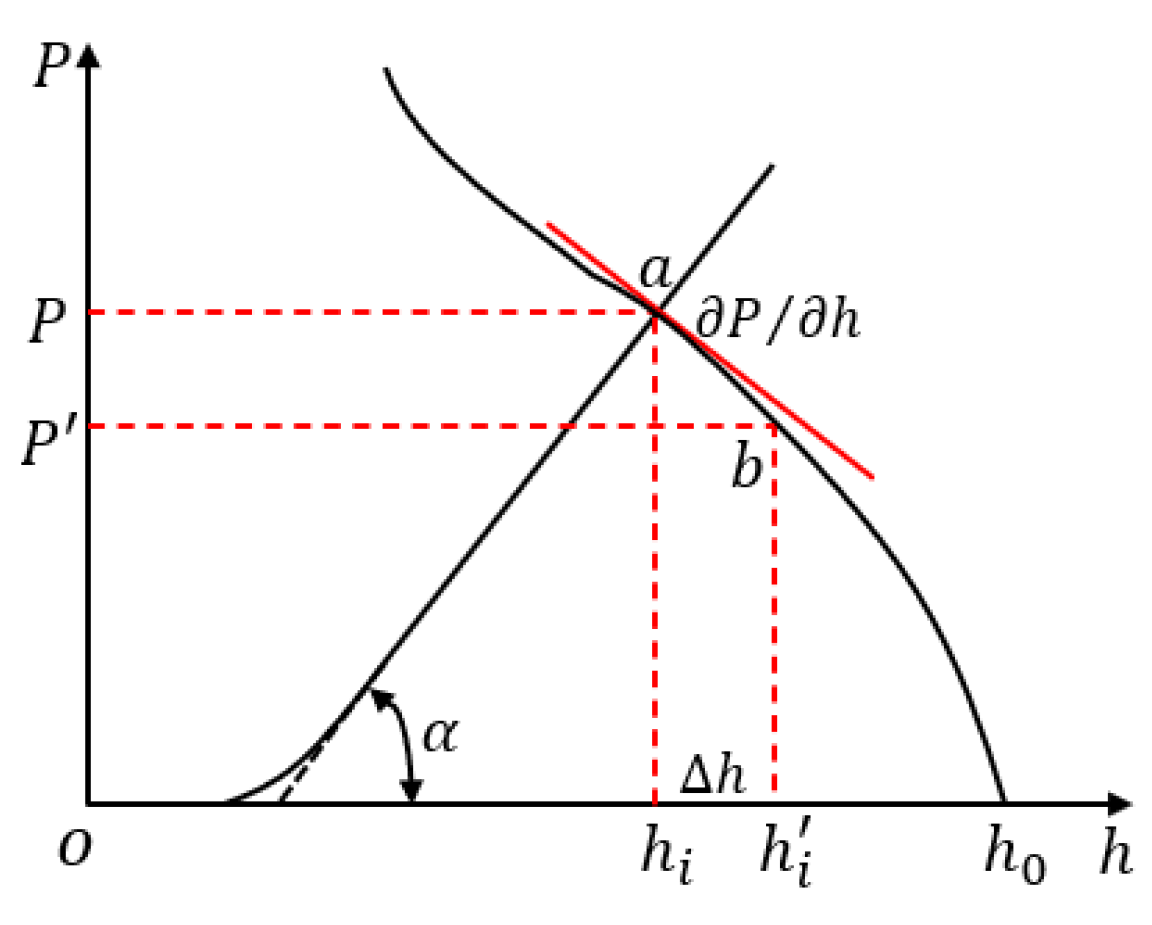
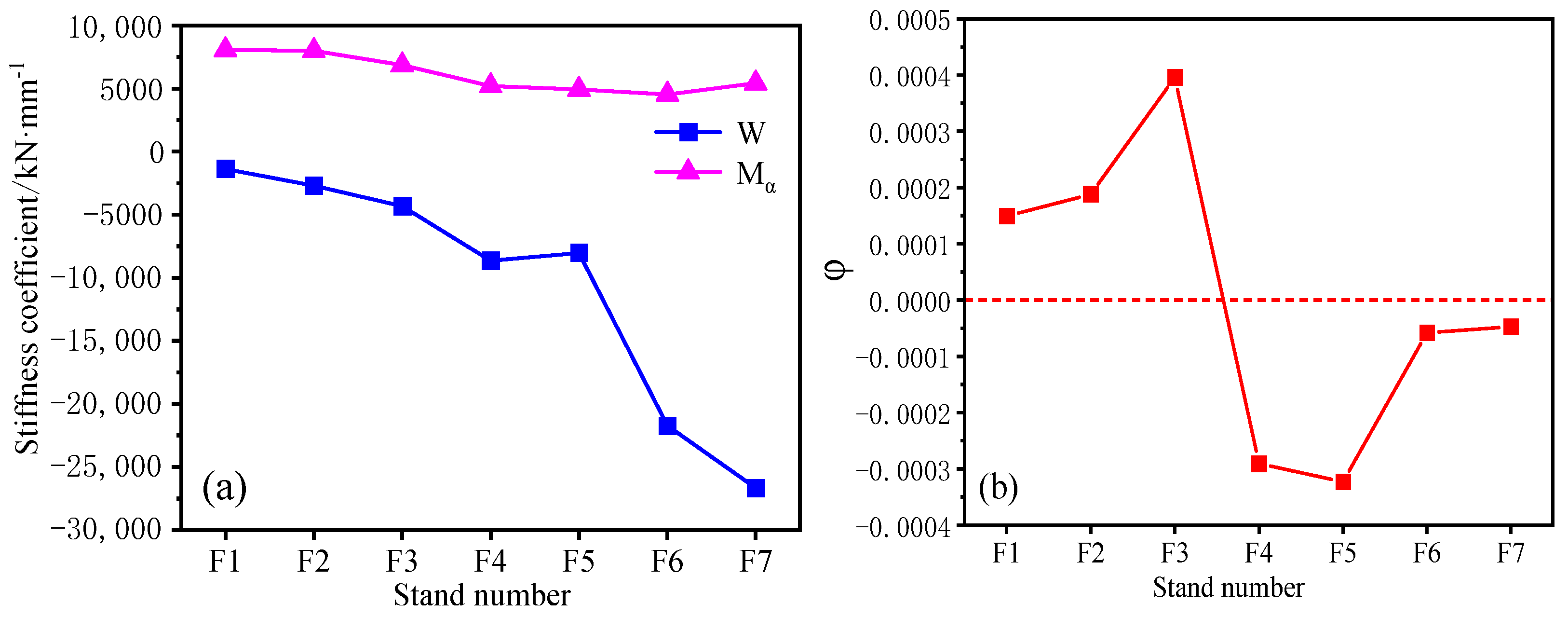
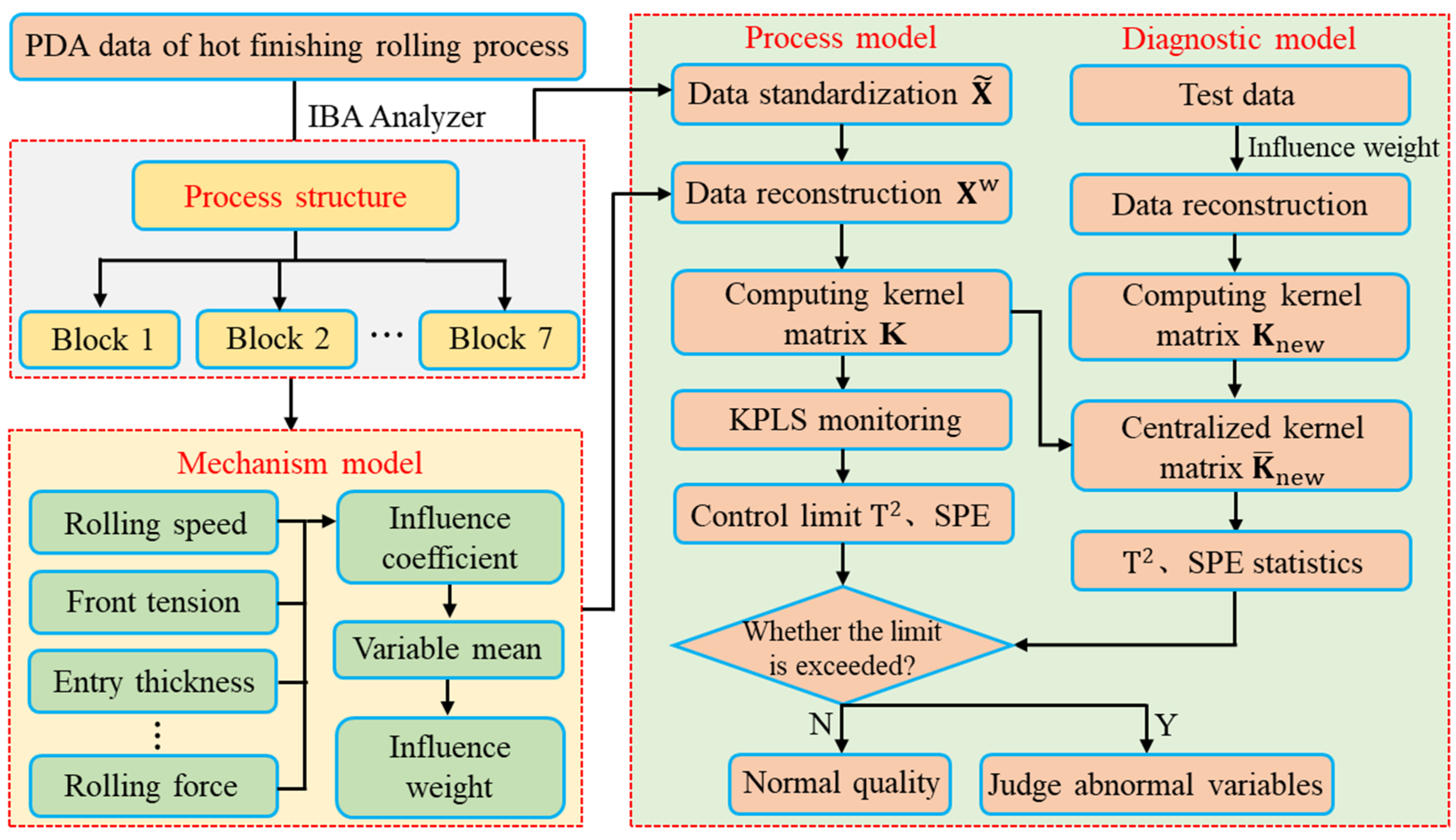




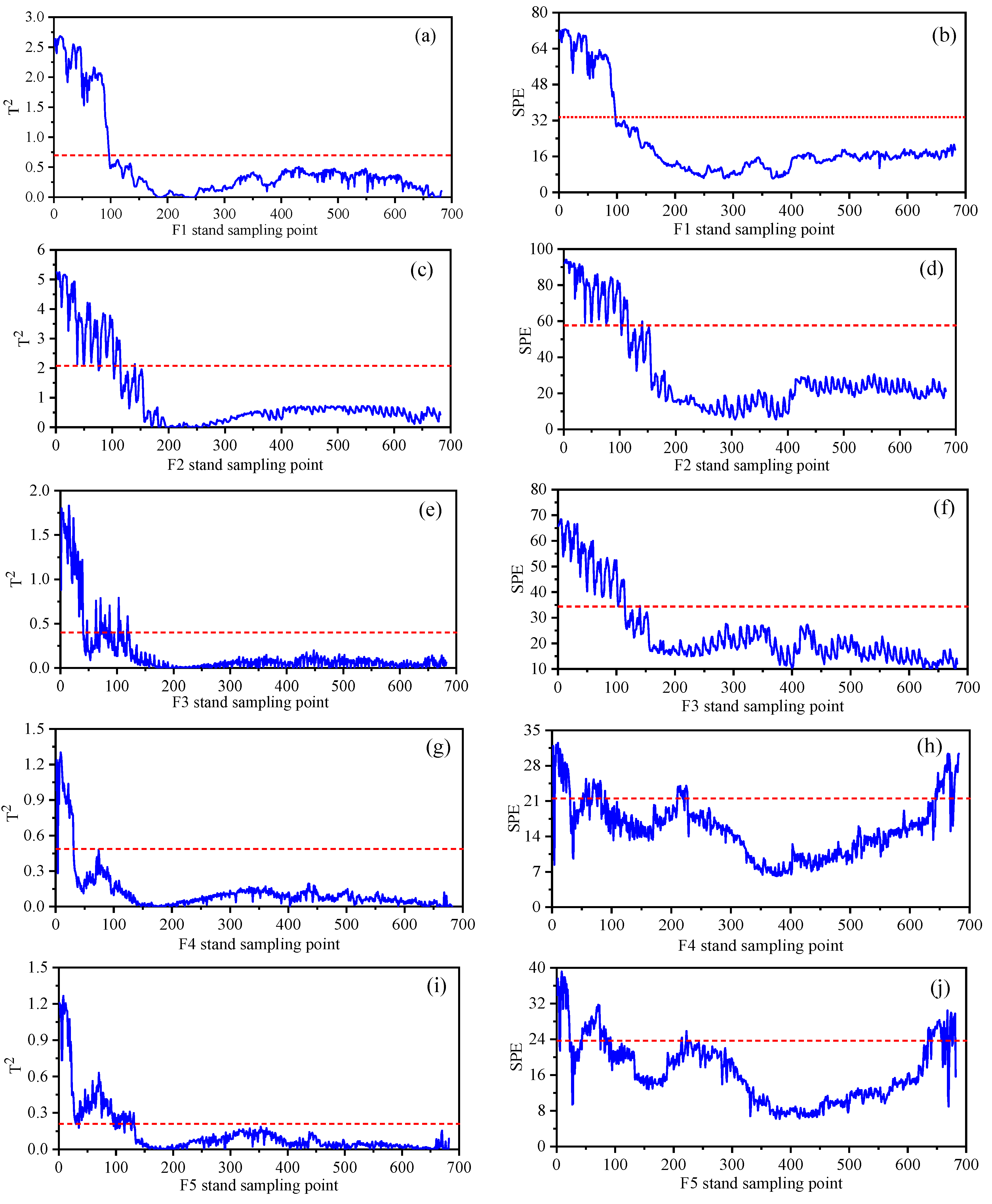
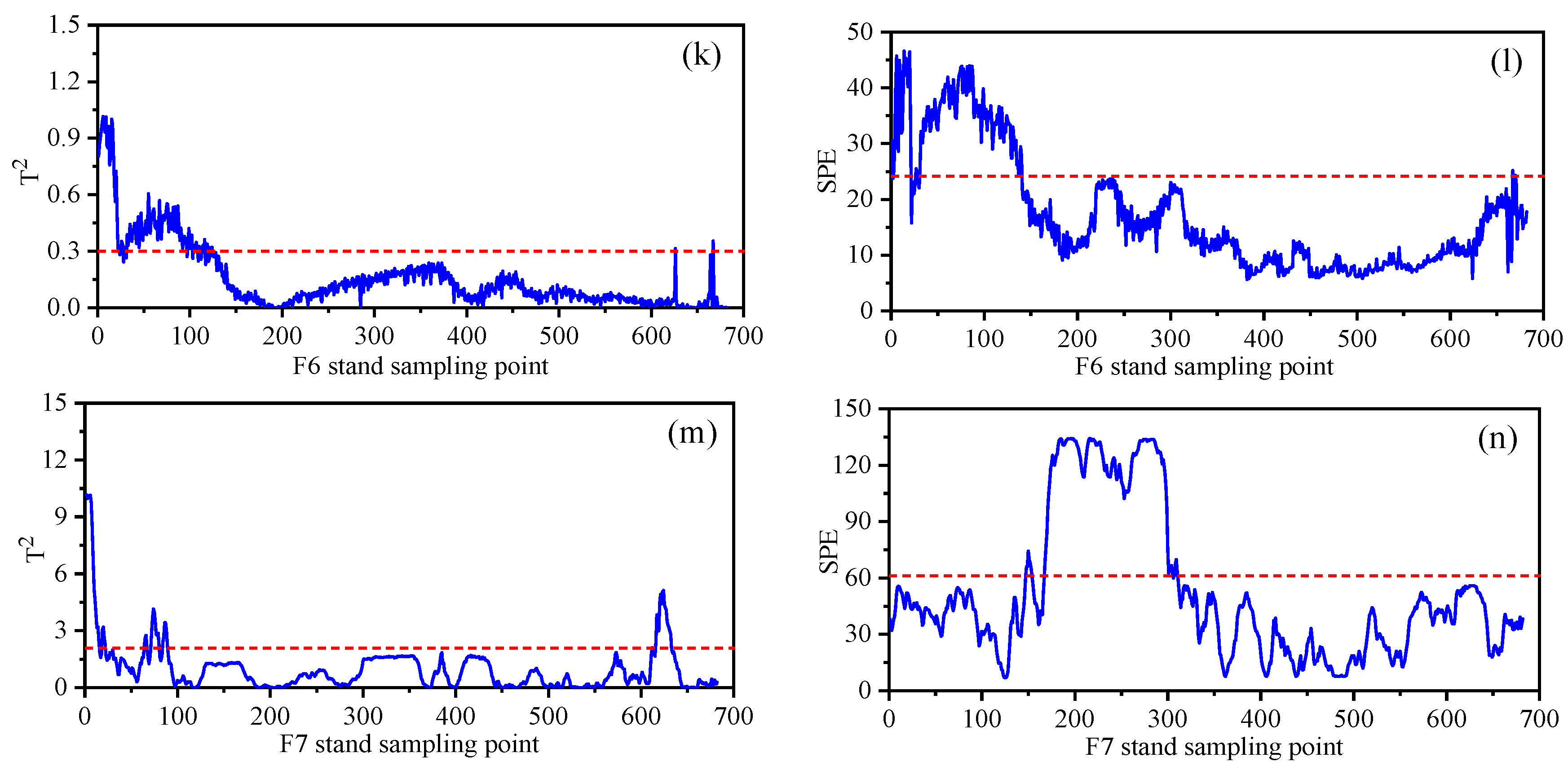
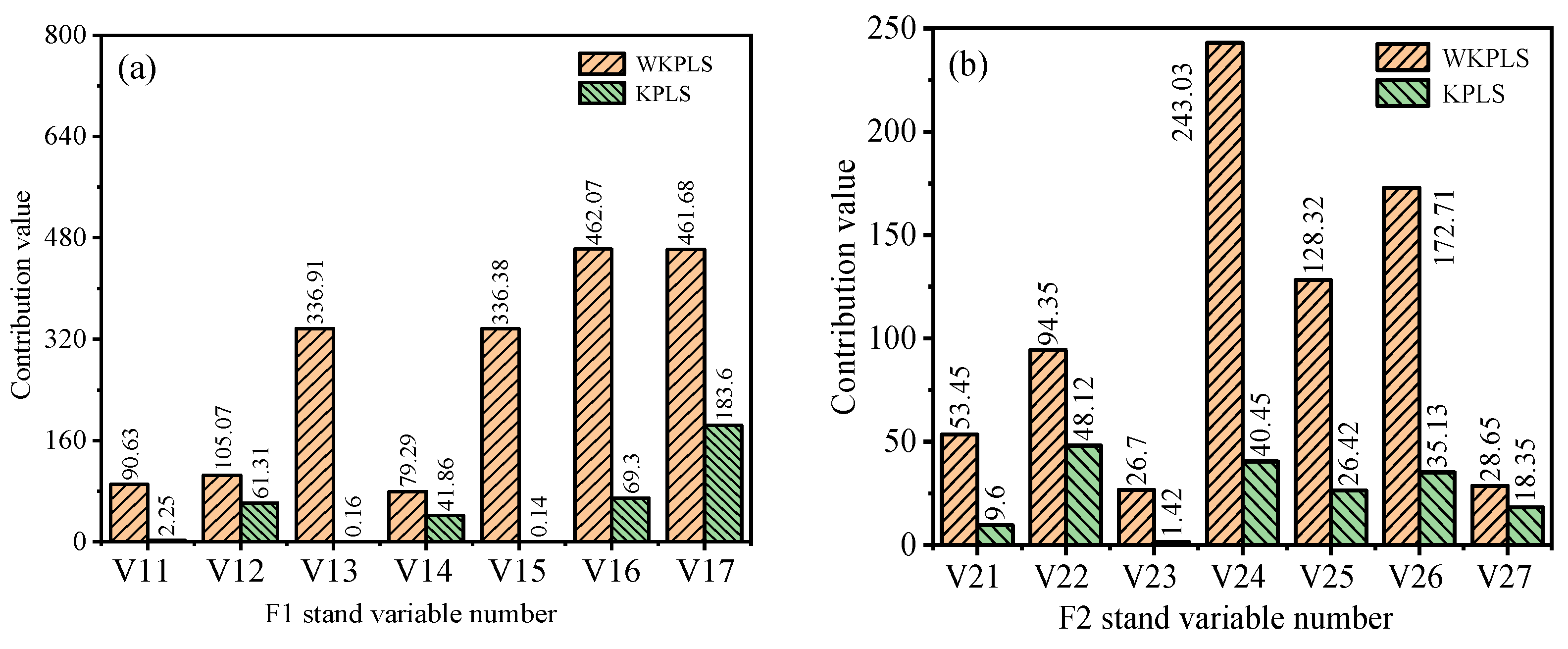
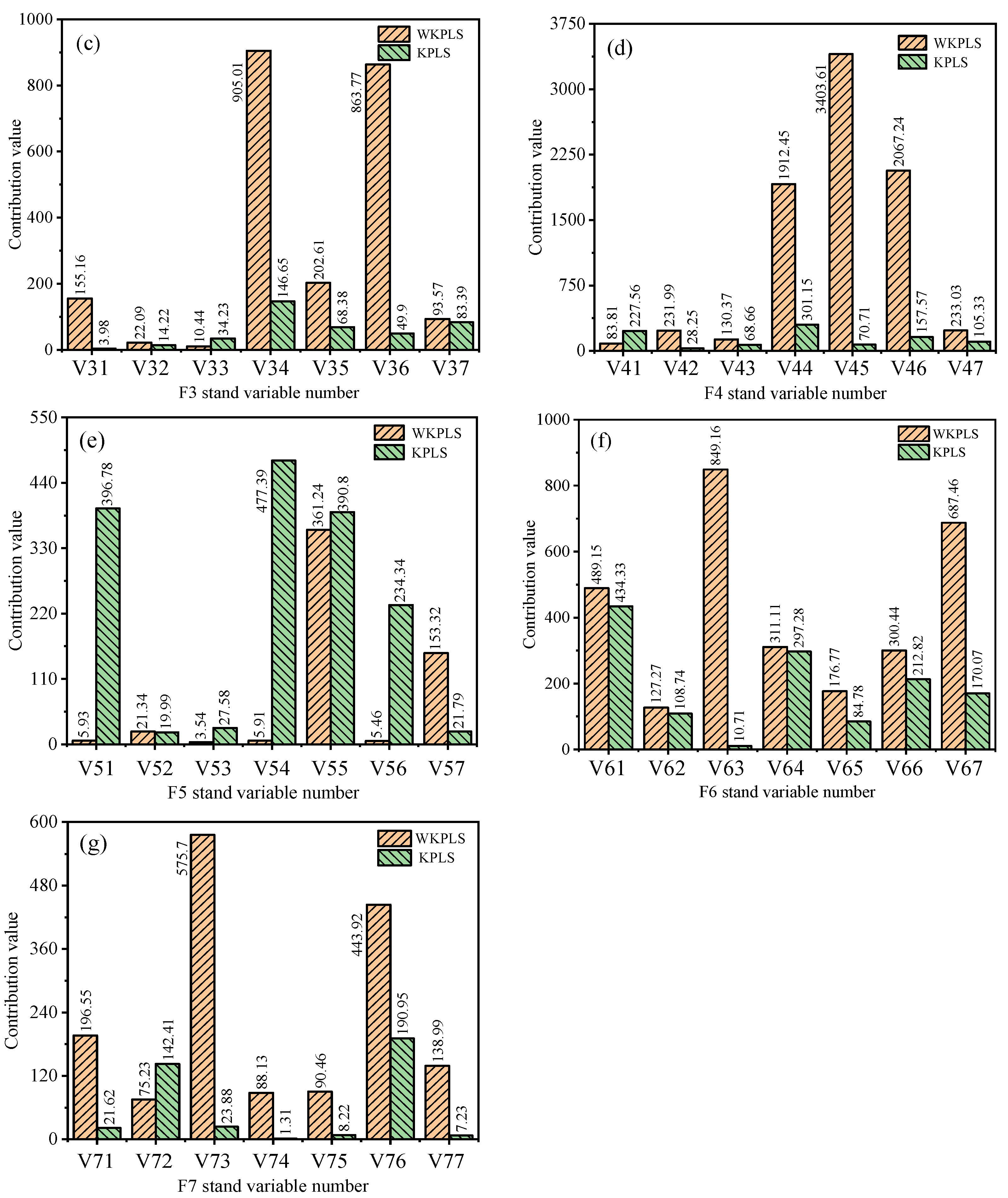
| Name | Influence Coefficient | Expression | Name | Influence Coefficient | Expression |
|---|---|---|---|---|---|
| Roll gap influence coefficient | Front tension influence coefficient | ||||
| Influence coefficient of incoming material thickness | Friction coefficient influence coefficient | ||||
| Influence coefficient of back tension | Influence coefficient of deformation resistance of a rolled piece |
| Stand No. | /mm | /mm | The Partial Differential Value of Thickness Difference Influences Coefficient | ||||
|---|---|---|---|---|---|---|---|
| Rolling Speed | Front Tension | Back Tension | Entry Gage | Temperature | |||
| F1 | 38.00 | 20.10 | 6069.20 | 28.86 | - | 8496.15 | 17.92 |
| F2 | 20.10 | 11.90 | 4340.37 | 33.74 | 18.58 | 8691.76 | - |
| F3 | 11.9 | 7.15 | 4557.55 | 5.17 | 5.89 | 9293.33 | - |
| F4 | 7.15 | 5.30 | 2004.74 | 4.28 | 2.22 | 7814.92 | - |
| F5 | 5.30 | 3.79 | 1345.66 | 2.30 | 2.34 | 6893.20 | - |
| F6 | 3.79 | 3.35 | 2082.96 | 2.25 | 11.95 | 5500.63 | - |
| F7 | 3.35 | 3.00 | 864.60 | - | 4.24 | 5168.80 | 81.92 |
| Variable Name | F1 | F2 | F3 | F4 | F5 | F6 | F7 |
|---|---|---|---|---|---|---|---|
| Rolling speed (m/s) | V11 | V21 | V31 | V41 | V51 | V61 | V71 |
| Front tension (MPa) | V12 | V22 | V32 | V42 | V52 | V62 | - |
| Post tension (MPa) | - | V23 | V33 | V43 | V53 | V63 | V72 |
| Entry thickness (m) | V13 | V24 | V34 | V44 | V54 | V64 | V73 |
| Rolling force (MN) | V14 | V25 | V35 | V45 | V55 | V65 | V74 |
| Roll gap value (m) | V15 | V26 | V36 | V46 | V56 | V66 | V75 |
| Roll bending force (N) | V16 | V27 | V37 | V47 | V57 | V67 | V76 |
| Inlet temperature (°C) | V17 | - | - | - | - | - | - |
| Outlet temperature (°C) | - | - | - | - | - | - | V77 |
| Thickness (m) | - | - | - | - | - | - |
| Stand No. | Influence Coefficient | |||||||
|---|---|---|---|---|---|---|---|---|
| Rolling Speed | Front Tension | Post Tension | Entry Thickness | Rolling Force | Roll Gap Value | Roll Bending Force | Temperature | |
| F1 | 0.90721 | 0.00431 | - | 1.270 | 0.0000499 | 1.20478 | 0.00064 | 0.00268 |
| F2 | 0.81740 | 0.00635 | 0.00350 | 1.637 | 0.0000606 | 1.50659 | 0.00057 | - |
| F3 | 1.80425 | 0.00205 | 0.00233 | 3.679 | 0.0001224 | 2.71180 | 0.00118 | - |
| F4 | 0.58210 | 0.00124 | 0.00065 | 2.269 | 0.0001051 | 1.50987 | 0.00127 | - |
| F5 | 0.43436 | 0.00074 | 0.00075 | 2.225 | 0.0001390 | 1.59135 | 0.00199 | - |
| F6 | 0.12107 | 0.00013 | 0.00069 | 0.320 | 0.0000286 | 0.26331 | 0.00099 | - |
| F7 | 0.04069 | - | 0.00020 | 0.243 | 0.0000336 | 0.25505 | 0.00215 | 0.00385 |
| Stand No. | Mean Value of Each Variable | |||||||
|---|---|---|---|---|---|---|---|---|
| Rolling Speed | Front Tension (MN) | Post Tension (MN) | Entry Thickness (m) | Rolling Force (kN) | Roll Gap Value (m) | Roll Bending Force (kN) | Temperature (°C) | |
| F1 | 1.20 | 6.51 | - | 0.0194 | 24,130 | 0.02 | 1877.27 | 980 |
| F2 | 2.10 | 8.86 | 6.51 | 0.0103 | 24,870 | 0.01 | 2629.76 | - |
| F3 | 3.53 | 11.61 | 8.89 | 0.0056 | 22,130 | 0.0061 | 2290.81 | - |
| F4 | 5.22 | 13.79 | 11.61 | 0.0048 | 14,370 | 0.0052 | 1187.13 | - |
| F5 | 6.88 | 17.06 | 13.77 | 0.0037 | 11,450 | 0.0037 | 798.03 | - |
| F6 | 8.30 | 19.91 | 17.05 | 0.0035 | 9190 | 0.0035 | 266.12 | - |
| F7 | 9.32 | - | 19.95 | 0.0035 | 7600 | 0.0034 | 118.78 | 880 |
| Method | PLS | KPLS | TPLS | WKPLS |
|---|---|---|---|---|
| Detection rate | 0.66 | 0.87 | 0.9 | 0.96 |
| Steel Coil Number | Specifications (mm) | Fault Detection Rate (%) | False Alarm Rate (%) |
|---|---|---|---|
| 8E00367A20xxAxxx | 3 × 870 | 97.21 | 4.12 |
| 8E00323A30xxAxxx | 3 × 866 | 95.60 | 6.42 |
| 8E00324A10xxAxxx | 3 × 866 | 94.14 | 6.61 |
| 8E00327A20xxAxxx | 3 × 861 | 98.02 | 4.33 |
| 8E00328A50xxAxxx | 3 × 866 | 95.60 | 6.42 |
| Mean | 96.11 | 5.58 | |
Disclaimer/Publisher’s Note: The statements, opinions and data contained in all publications are solely those of the individual author(s) and contributor(s) and not of MDPI and/or the editor(s). MDPI and/or the editor(s) disclaim responsibility for any injury to people or property resulting from any ideas, methods, instructions or products referred to in the content. |
© 2023 by the authors. Licensee MDPI, Basel, Switzerland. This article is an open access article distributed under the terms and conditions of the Creative Commons Attribution (CC BY) license (https://creativecommons.org/licenses/by/4.0/).
Share and Cite
Guo, H.; Sun, J.; Yang, J.; Peng, Y. Quality-Related Process Monitoring and Diagnosis of Hot-Rolled Strip Based on Weighted Statistical Feature KPLS. Sensors 2023, 23, 6038. https://doi.org/10.3390/s23136038
Guo H, Sun J, Yang J, Peng Y. Quality-Related Process Monitoring and Diagnosis of Hot-Rolled Strip Based on Weighted Statistical Feature KPLS. Sensors. 2023; 23(13):6038. https://doi.org/10.3390/s23136038
Chicago/Turabian StyleGuo, Hesong, Jianliang Sun, Junhui Yang, and Yan Peng. 2023. "Quality-Related Process Monitoring and Diagnosis of Hot-Rolled Strip Based on Weighted Statistical Feature KPLS" Sensors 23, no. 13: 6038. https://doi.org/10.3390/s23136038
APA StyleGuo, H., Sun, J., Yang, J., & Peng, Y. (2023). Quality-Related Process Monitoring and Diagnosis of Hot-Rolled Strip Based on Weighted Statistical Feature KPLS. Sensors, 23(13), 6038. https://doi.org/10.3390/s23136038






